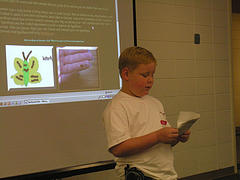I posted my first Flat Classrooms blog yesterday, and the topic wiki has already attracted some attention. In that original post, I went ahead and fleshed out some characteristics for the Flat Classroom Student. Magically, additional qualities have appeared for the teacher, physical learning environment, and curriculum of a flat classroom. Amazing!
 I’d like to put some of my thoughts down today, concerning the first two characteristics of the student of a flat classroom — curiosity and self-directed learners. It is often said that students enter our classrooms as curious beings. I suspect that if we truly watched children at play, without the hindrances of classroom regiment, we would also identify characteristics of a self-directed learner. Yet, appearances indicate that somewhere along the way of their elementary and middle school years, childish curiosity and desire to put themselves to learn for its intrinsic value, seems to go away — at least in terms of the learning expectations that are stipulated by our governments, and probably from the perspectives of most middle and high school teachers.
I’d like to put some of my thoughts down today, concerning the first two characteristics of the student of a flat classroom — curiosity and self-directed learners. It is often said that students enter our classrooms as curious beings. I suspect that if we truly watched children at play, without the hindrances of classroom regiment, we would also identify characteristics of a self-directed learner. Yet, appearances indicate that somewhere along the way of their elementary and middle school years, childish curiosity and desire to put themselves to learn for its intrinsic value, seems to go away — at least in terms of the learning expectations that are stipulated by our governments, and probably from the perspectives of most middle and high school teachers.
I suspect, though, that curiosity does not truly leave, nor does our children’s desire to accomplish their own learning within topics that interest them. A flat classroom must invite curiosity back into the formal learning environments, by nature of its flatness. It values the students’ intrinsic learning needs, as much as it values the teacher’s position as one who can facilitate learning. Absolutely nothing new here, especially for those of us who spent our years in the education schools of the 1970s, reading A.S. Neill and James Herndon.
The learning engine, though, must feed on the energy of curiosity in order to move, and we should come to agreement that in a flat world where the answers are changing, it’s the process of the question that is becoming more important. It’s more important how we learn than what we learn.
So how do we respect student’s curiosity — in today’s classroom? Very difficult, when nearly every day is spent trying to cover the state standards. What I woke up this morning thinking about, was an annual assignment that all of my students would receive. They are tasked with delivering a presentation to the class on a topic that I, as the teacher, and at least five other students agree would be of interest and value to the class. Then the student would set about, on their own time, conducting the research, planing the presentation, and constructing the audio/visual elements that they will need. Each student project will have a student advisory committee who will continuously evaluate their preparations, and when all members of the committee have agreed (based on a either a standard or customized rubric) that the project is ready, then the student will deliver the presentation to the class.
The presentation would be recorded and digitized, along with all of the ancillary materials, and it will be archived in the school library for later reference and for the creation of derivative works by future students. In addition, any other class in the school can request that the student deliver the presentation for their students. The presenter becomes an expert, and in most cases, that expertise grows.
In return for a presentation that receives a specified evaluation from the entire class, the student can exchange a perfect score for any three, or four, or ten other grades earned in the class during the year.
OK, this is all lincoln logs, and you can knock it apart and put it back together in any way you want. But the goal is to invite curiosity, value self-directed learning, and perhaps help students learn to make themselves experts, a critical skill for a flat world.
Remember that the The wiki page is at: http://flatclass.davidwarlick.com/

One thought on “Flat Classrooms — Curious Students”